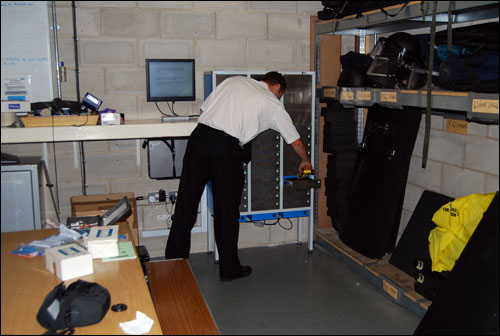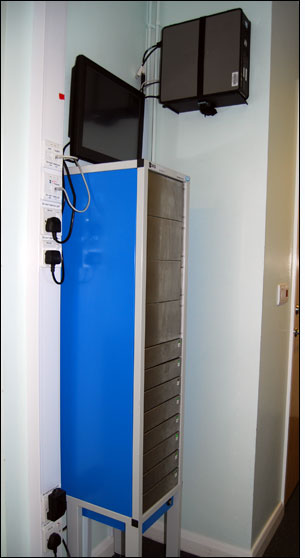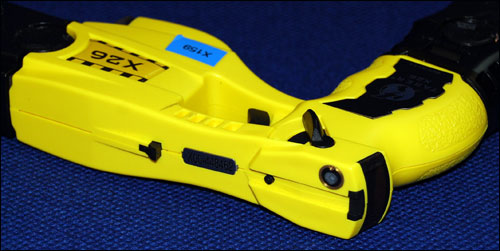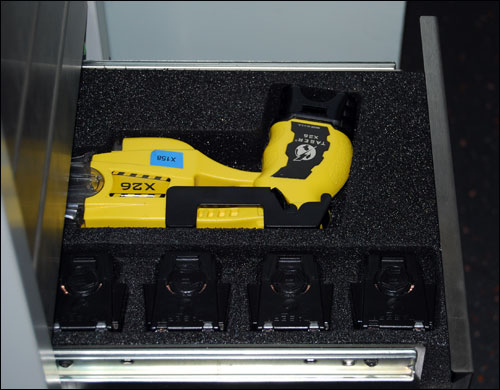To manage the rollout of Tasers for use by some of its 2,500 police officers, the U.K.’s Nottinghamshire Police Department (Notts Pol) has deployed RFID-enabled cabinets at four of its police stations. The cabinets are designed to ensure that only officers authorized to access the Tasers can actually do so. The system also maintains a record of which personnel uses the devices, as well as the condition the weapons are in and how often a specific officer has fired them.
Most British police do not carry firearms, and until recently, they were not permitted to carry Tasers either. Software firm JML Software Solutions already deployed an RFID-based system at Notts Pol’s armory to track the usage of guns for select officers. An authorized special service officer who requires a gun can enter the armory through an RFID portal, which reads the ID number on that individual’s identity card. As he or she exits the armory, the RFID number on a tag attached to the gun is also read, thereby linking the weapon with that particular officer. If the officer then fails to return the weapon, an alert can be issued to department officials.
Recent changes in British law allow police officers with the appropriate training to use Tasers. Notts Pol covers an area of 800 square miles, with a population of more than 1,000,000 people, in a combination of urban and rural areas. The department employs 2,500 uniform and plain-clothes officers, as well as 1,500 police support staff members to cover the area. At present, 160 officers carry Tasers while on duty.
“The problem for them was they don’t have an armory for every police station,” says Luis Ponte, JML’s CEO, so it wasn’t possible to track Taser use with an RFID-enabled portal at an armory entrance. Therefore, JML suggested an RFID solution to track the devices.

The system, known as the Intelligent Drawer Armory System (iDAS), was developed with the assistance of RFIP Ltd., and employs RFID hardware provided by Tagsys.
Early this year, says Nigel Rippon, Notts Pol’s systems administrator, it was decided that the police department “would train and equip all firearms officers in the use of Tasers, as well as 85 Specially Trained Units [STUs] comprising motorway patrol officers, territorial support groups, dog handlers, etc.”
Because of the large size of the policing area, the department chose to store Tasers at several key stations that could provide ease of access and deployment. According to Rippon, there were an insufficient number of Tasers to issue individually to every officer.
“This raised the issue of security of Tasers, combined with the need for a robust system of auditing—issuing and return, usage and maintenance,” Rippon says. The department had researched using manually locked cabinets, together with paper audit records, but found that such a system would allow errors if paperwork was not filled out properly.

JML recommended RFID-enabled cabinets with drawers, each of which would store a specific Taser and its cartridges, and which would lock until it was authorized to be opened for an officer when an RFID badge was presented to the cabinet’s reader. JML enlisted RFIP to oversee the RFID technology, and RFIP selected Tagsys hardware. In the meantime, because the department already utilized JML software to manage reader data from the armory, the company simply added a new function to that software to include the cabinet data.
The department initially tested the system at four of its police stations beginning in June of this year, with a total of 60 drawers. Each cabinet comes with two Tagsys Medio P032 RFID readers—one to capture the ID numbers of Tagsys Ario 370-SDM (Small Disc Module) 13.56 MHz tags, which comply with the ISO 15693 standard, and another to capture the IDs of police ID cards outside the cabinet. Each has a total of up to 16 drawers in columns and rows, with an electronic lock on each drawer, and an array of antennas distributed throughout the cabinet to read the ID numbers of every tag in each drawer.
Upon arriving for a shift, an officer presents his or her ID card to the interrogator installed on the wall beside the cabinet, and inputs his or her password number on a keypad. The ID number is captured by the RFID reader and passed on to the back-end system via an Ethernet connection. JML’s Web-based software links to Nott Pol’s Oracle back-end system software, in order to confirm whether the ID number and password match, as well as whether that officer has the training necessary to be authorized for Taser use.
If there is a match and the officer is authorized to use the Taser, a screen then displays a series of questions and instructions, including asking the officer if he or she has had any alcoholic beverages, and advising that individual regarding the safe usage of Tasers. Once the officer has responded to these messages, the JML software calculates which Taser in the cabinet should be used next, based on each device’s level of usage. The appropriate drawer then opens, and the officer can remove the Taser and cartridges.
Each Taser has a Tagsys RFID tag, measuring 7.9 millimeters (0.3 inch) in diameter and 1 millimeter (0.04 inch) thick, attached to its top by an adhesive. When the Taser has been removed, the cabinet interrogator no longer reads the ID number of the weapon’s tag, and the software then determines that the officer has removed it. Upon returning the Taser, the officer again presents his or her ID card and password, signs onto the screen—thereby confirming that he or she is the officer returning the Taser, and not another individual—and then answers another series of questions, such as whether the weapon was used (and, if so, the number of cartridges fired) and whether it operated properly. An empty drawer in the cabinet then opens. The officer then places the Taser and any unused cartridges into the drawer, which closes automatically. The cabinet’s RFID interrogator then reads the Taser’s tag, verifying that the weapon has been returned.
The officer’s responses are stored in the software, thereby enabling the department to track each weapon’s condition. In addition, if the officer reports that the Taser failed to operate properly, an alert is sent to the individual responsible for maintaining the devices. In the meantime, the drawer for that Taser remains locked to anyone except the individual authorized to maintain it.
The system, Ponte says, includes a safety feature as well, in order to ensure that a tag is not removed from a Taser and returned to the drawer, thus indicating to the system that the Taser was returned when it really wasn’t. Although he declines to describe how that feature is accomplished, he says it uses hidden disruptor tags.
The cabinet allows Notts Pol to know which individual has which Taser, in real time, and also enables the department to remotely maintain an audit trail of Taser usage. Via the system, the department can track the behavior of officers (for example, those who may be utilizing the Tasers more than others, and who might require additional training) and also track each weapon’s usage.
“It has provided an opportunity to securely store weapons in remote locations whilst maintaining a creditable secure facility that can be monitored from remote locations,” Rippon says. “The cabinets have provided a secure, keyless facility that has removed the need for paper records and manual issue.”
Since the system went live in April, Rippon notes, Tasers have been issued for patrol use more than 9,000 times. “All officers have adapted well to the new process,” he states, “with minimal instruction and supervision.”



